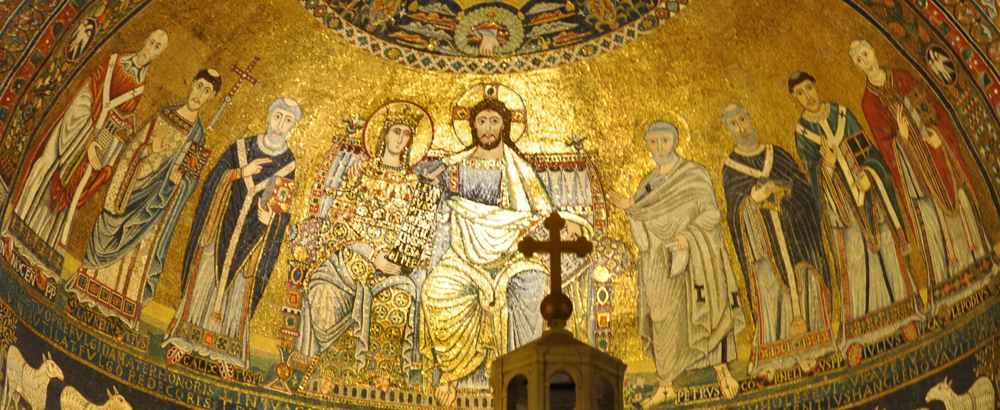
Pietro Cavallini, The Apse Mosaic at Santa Maria in Trastevere: Detail, the central portraits

1291
Mosaic
Basilica of Santa Maria in Trastevere, Rome
The scroll in the woman's hand
(close-up)
links her to the bride in the Song of Solomon. It reads Leva eius sub capite meo et dextera illius amplesabitur me, "His left hand is under my head, and his right hand shall embrace me" (Song of Songs 2:6, 8:3). Christian writers interpret the bride as Ecclesia, the Church: see my page on Ecclesia. At the same time, the phrase in Christ's book
(close-up)
links her to the Mary of the Assumption: Veni electa mea et ponam in te thronum meum, "Come, my chosen one, and I shall put you on my throne," from Christ's wordsto Mary in the Golden Legend's account of her welcome in Heaven (Ryan II, 79). The bride is thus imagined as both the Virgin Mary and Ecclesia, the Church.
The image of the two figures seated on the one throne also has Christological significance in representing Christ the God-Man. And the God-Man as sacrificial victim is then symbolized by the Lamb directly below the throne. (In this photograph the Lamb is barely visible behind the summit of the ciborium. It has a red cruciform halo.)
The other lambs represent the apostles, 12 in all. (See the context photograph below, or click on it to see a larger copy.)
Six figures in clerical vestments flank the throne. The labels identify them as (left to right) Pope Innocent II, who restored the church in the 13th century; St. Lawrence, dressed here as a deacon; Pope St. Callixtus; Pope St. Cornelius; Pope St. Julius, who built the church in the 4th century; and St. Calepodius. St. Peter stands as if a bit forward of the group and closer to the throne. He wears a toga and holds a scroll.
Old Testament prophecies of the God-Man and his sacrifice are the subject of the two portraits to the left and right of the apse. The figure standing on the left is labeled ISAIAS PROPHETA, "The Prophet Isaiah." He holds a scroll reading ECCE VIRGO CONCIPIET ET PARIET FILIUM, "Behold a virgin shall conceive and bear a son" (Isaiah 7:14). On the right, the standing figure is HIEREMIAS PROPHETA, whose scroll reads xpc dominus captus est in peccatis nostris, "Christ the Lord is taken in our sins" (Lamentations 4:20).

The sequence of mosaics below the prophets and the lambs presents the life of the Virgin Mary: her birth on the far left, then the Annunciation, Nativity, Presentation in the Temple, and Dormition.
At the very top the creatures representing the four Evangelists flank a cross with the alpha and omega, the first and last letters of the Greek alphabet, referring to God's words, "I am the alpha and the omega, the beginning and the end" (Revelation 1:8, 21:6, 22:13).
View this image in full resolution.
View the apse in its setting.
Read more about images of Ecclesia.
Read more about images of Christ in Majesty.
Photographed at the basilica by Richard Stracke, shared under Attribution-NonCommercial-ShareAlike license.